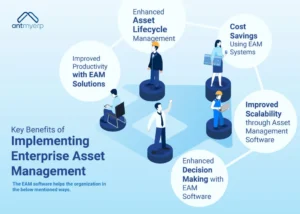Customized EAM Software: Benefits of Implementation
2024-08-07
Organizations in the service industry look for solutions to optimize their assets. For this purpose, enterprise asset management (EAM) software has gained a lot of popularity in the past few years. EAM software not only helps in optimizing the assets but also aids in maintenance processes. Effective asset performance management can reduce operational costs significantly. EAM solutions help organizations manage their assets through their entire lifecycle management, from acquisition to maintenance and finally disposal. This elaborate approach not only improves operational efficiency but also contributes in saving a lot of cost to the company.
“In today’s competitive landscape, managing assets efficiently is not just an operational necessity but a strategic advantage.” – David Smith
These days service providers offer customized features of EAM software to meet the precise needs of their clients. This enables them to better align with the organizational needs. In this blog, we will see the challenges that the organizations face in the absence of enterprise asset management software. We will also see the benefits the businesses can reap from the software. Lastly we will discuss the future trends in the asset management sector. Let’s quickly dive in!
Challenges in the Absence of EAM Software
Without EAM solutions, organizations switch to manual methods for asset management which make them prone to errors. This increases the downtime and unresolved maintenance costs due to the lack of preventive maintenance. Also, gathering data manually is time consuming with a lot of errors. Due to this the performance of the assets cannot be gauged precisely and can hinder effective decision making. Additionally, the lack of elaborate documentation leads to the risk of compliance and other penalties. Overall, it can be clearly said that the absence of EAM software can lead to operational inefficiencies and poor cost management.
Key Benefits of Implementing Enterprise Asset Management
The EAM software helps the organization in the below mentioned ways.

Improved Productivity with EAM Solutions
Customized EAM software helps to align the asset management with certain business workflows. The automated features help to reduce the manual tasks and hence the errors. It helps in accelerating operations and enhancing overall productivity. For instance, the software can track and automate scheduling to assign the task to the engineer available and monitor the task to gauge productivity.
Enhanced Asset Lifecycle Management
A customized EAM software provides advanced asset tracking and management throughout their lifecycle. This includes planning for preventive maintenance by forecasting the issues at their infancy. By improving the lifespan of the assets and optimally using them, the organizations save overall costs.
Cost Savings Using EAM Systems
The EAM system helps in significant cost savings. By planning maintenance, reducing downtime and enhancing resource utilization, businesses can reduce repair and maintenance costs. Custom reports help in avoiding unnecessary expenditure, contributing to overall finances of the organization.
Improved Scalability through Asset Management Software
As the business grows, their need for assets also increases. The enterprise asset management software provides the flexibility and scalability that the organization needs over time. It allows the organization to expand their business and adapt to the new processes.
Enhanced Decision Making with EAM Software
Customized EAM software provides the real-time data and tailor-made reports on various parameters. The custom dashboards and analytics help in making an informed decision for the future asset management. This enhances the operational efficiency which also aligns with the long term goals of the organization.
Future Trends of Digital Asset Management
The advancement in technology has rapidly changed the future of EAM software with the evolving business needs. One of the most significant advancements is IoT in asset management. This allows the real time monitoring and data collection from the connected assets. This in turn helps in forecasting predictive maintenance schedules and enables precise asset management. Artificial Intelligence and Machine Learning have also set their foot in asset management. They provide advanced analytics and automation processes.
Another future trend that is spreading widely is the use of mobile accessibility which is becoming widespread. It helps the field technicians to stay updated on the go and act promptly on the services. This reduces the response time as well as the downtime of the asset. Cloud-based EAM solutions are the future of asset management. They are becoming widespread due to their scalability, flexibility and lower costs. Along with that, Augmented Reality (AR) is beginning to play their role in asset management as they provide real-time guidance in maintenance tasks and also help in training. The future of EAM software is more connected, intelligent and adaptable which is a plus for the organizations dealing with it.
Final Thoughts
With all the discussion we can say that EAM software is the future of asset management. It not only helps in enhancing the operational efficiency but also saves a lot of cost to the company. As the future of asset management evolves, the new integrations with IoT, ML, AI etc. will only improve the ways in which the organizations deal with their assets. Organizations embracing the EAM software technology will position themselves better in the competitive market. By investing in such a technology, the business not only deals with the current issues but also prepares itself for a better future. This ensures long term success and sustainability.
AntMyERP is here to help you with all the guidance that you need for asset management. Let’s get connected.
Next Steps
Book a 15 day free trial with us!
Get the detailed field service software pricing here.
Want to get ensured before you invest? We got you covered! Find the reviews of some of our clients here.

